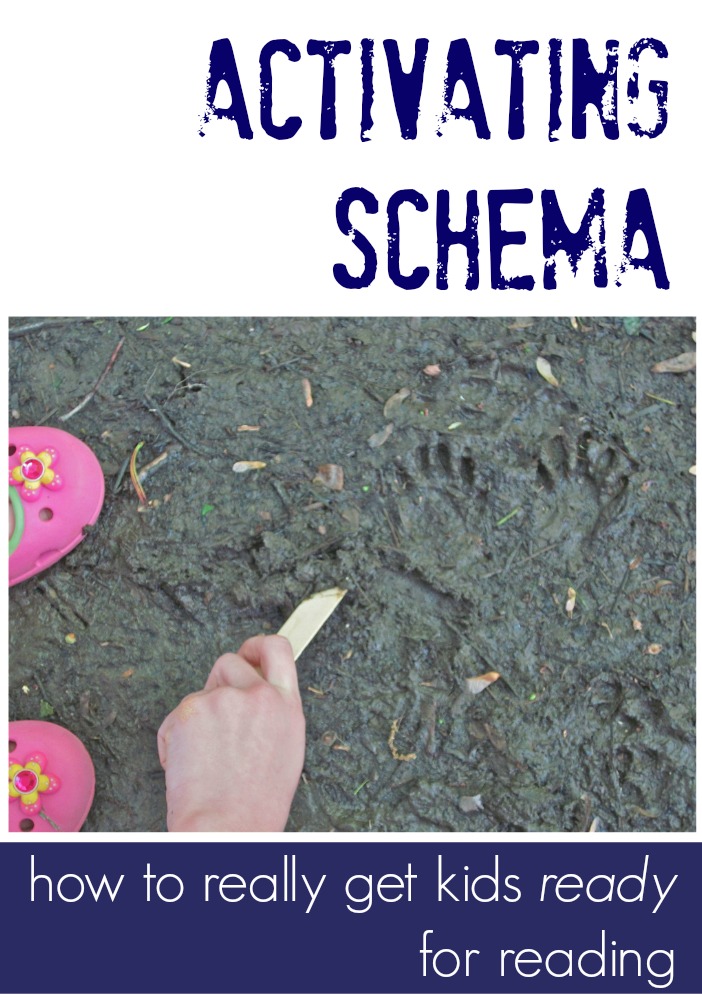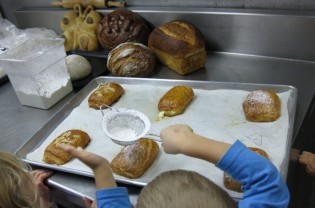
According to Rachel and Mary Gabriel, the “schema theory tells us that prior knowledge is essential for comprehension of new knowledge and that learning difficulties can often be traced back to insufficient background knowledge” (Gabriel & Gabriel, “Power in Pictures: How a Schoolwide Photo Library Can Build a Community of Readers and Writers.” The Reading Teacher, 63(8), pp. 679.).
Parents and teachers can help our little ones pull from their growing schema so that they can better understand and appreciate the texts we’re reading to them in read-alouds. Activating their prior knowledge or experience with a certain topic will increase their comprehension even before the children are reading the text themselves.
We can do this with ease, and it won’t take too much time at all.
And watching that lightbulb go off for your kiddo when she picks up a book about animal footprints and you remind her about the time she found raccoon prints (or whatever they were!), on the walk to the park last spring–it’ll be worth a million bucks. Not to mention that it’ll make her even more invested in the book and more able to make connections to the concepts, which will help her to understand everything that much better!
- Activating Schema: Activating schema is just a fancy schmancy way of saying that a person is pulling from prior experience or involvement with a topic in order to better understand a new subject.
We can show children how to activate schema in the short span of one read-aloud, and if we deliberately model and practice the technique, it can become a strategy kiddos will begin to use automatically!
Everyone knows that certain textures, tastes, sounds, or smells have the power to bring us back to an experience that may seem long forgotten. Maybe it’s the woman on the train wearing your grandmother’s perfume or the smell of your great-aunt’s famous pumpkin muffins wafting from a neighborhood bakery. Whatever it may be, one little spark can trigger an avalanche of memories, so it only makes sense to draw on those pieces of information (called, “schemata”) in order for our children to create new and fuller understandings.
 Reading a book about a bakery?
Reading a book about a bakery?
the smells, the sounds.
Depending on how much time, effort, and preparation you have, activating schema can be done with low-prep, medium-prep, or high-prep manner. Here are just a few of the many ways to activate prior knowledge:
- Low-Prep: Just talk about what your child knows about a subject before you read the text. Ask him, What do you remember about being on a plane? How did it sound? What did you eat? How did you feel? Then introduce the text and start reading!
- Medium-Prep: Gather several photos of your child from a time when she was in a situation similar to what he will read about in the text. Look at the pictures together and talk about what she sees in the photos, what she remembers personally from the experience, and what she liked–or disliked–about the experience.
- High-Prep: Create a box or bag filled with items that relate to the subject of a text. For a book about the beach, grab some seashells, sand, a towel, and sunscreen. Have your child take the items out, one by one, and chat about how the items feel, smell, sound, and taste (if applicable). Talk about what your child knows about each item and how those items connect to the subject of the book.
Activating schema is just one reading comprehension strategy that parents can model, practice, and use with their children during read-alouds. It doesn’t have to be something formal; you can go through these steps casually, and you can use it in along with other strategies–like connecting or predicting–to further increase your child’s understanding of a text. The more we use these strategies now, before our kids are reading, the more likely that the strategies will become habits when our readers get older!
Originally posted as a series on ABC and 123: A Learning Cooperative, this is part of a series I’m doing here on Learning During Read-Alouds.
Next up is a biggie, one that I’ve had help with from the experts over at we teach: 5 Things Never to Say to Emerging Readers.

I just modeled activating schema with a group today during a shared reading of “Spot Visits His Grandparents.” Between the four students and myself, we have grandparents in four different countries!
In a perfect world we would all do high prep lessons all the time with our students and our own children, but I appreciate your offering suggestions for low- and medium-prep options.
Thanks, Jeremy! Grandparents in FOUR different countries??! Wow–pretty impressive in such a small group!
I appreciate your comment more than you know and am glad it helped! Sure–high prep is ideal, but the reality. . . 🙂
That is so simple that I’m a little ashamed that I didn’t think of it all on my own! We do it all the time as adults–reading notes about a related topic before a meeting for example, or looking at pictures of our last vacation before starting out on the new one–and don’t even realize it. Thanks for posting this-we’ll put i into practice in about a half a day when we sit down to read “The Time Machine” tonight.
Thanks so much–truly appreciate your kind words! You’re so correct; we do this automatically as adults! And imagine how it can help improve our kids’ reading if we start them doing this now! 🙂
Great post, Amy! We’re big believers in the value of reading aloud for students of all ages. Very interesting to read about the theory behind it.
thanks so much, Ashley!!
Great to hear from you all the way over at k12!
Fabulous! I did this today with “Big Egg.” We discussed all the different size babies and how mommies love them all. (All our cousins, friends, etc.)
Super idea! Great way to get brains moving before you start reading!